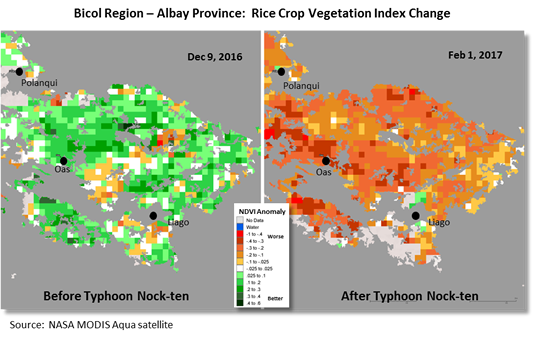PHILIPPINES: Recent Typhoons Result in Limited Rice Losses
Three powerful typhoons ploughed across the northern Philippines in October and December 2016, striking at the heart of the most important agricultural region of the country. Typhoon Sarika struck prime rice growing areas in mid-October 2016, causing widespread flooding and wind-related crop damage. It was followed several days later by Super Typhoon Haima, which stuck further north. Finally, Super Typhoon Nock-Ten ravaged the minor producing region of Bicol southeast of the capital, Manila, on Christmas day. These storms collectively impacted over 350,000 hectares of rice fields during the most important producing period of the year (October to December).

Preliminary post-typhoon assessments by Philippine government agencies indicate that much of the acreage damaged in the October storms will recover through replanting efforts. USDA, however, conservatively estimates that at least 150,000 hectares or 43 percent of total storm-affected rice acreage from the three storms will be unable to fully recover. As a result, USDA reduced estimated milled rice production by 500,000 metric tons in December to a total of 11.5 million metric tons for 2016/17. Hardest hit were the rice crops in Bicol province, which were in advanced growth stages at the end of December and will be permanently lost. The Philippines Department of Agriculture estimates that nearly 50,000 hectares were severely damaged by sustained 155 mile-per-hour winds as Typhoon Nock-ten scoured the lowlands surrounding Mt. Isarog in the Bicol provinces of Camarines Sur and Albay.

Though the Bicol region is frequently shrouded in cloud cover, satellite-derived evidence of crop losses on agricultural lands is widely apparent. MODIS NDVI (normalized difference vegetation index) illustrates the sharp contrast in crop conditions before and after Typhoon Nock-ten. In the December 9 image, it is apparent that crop conditions in Liago, Oas, and Polanqui were above average during the early grainfill growth stage. After the storm NDVI plummeted as shown by the February 1 image, indicating substantial crop damage. The region has limited irrigation and enters a 5-month dry season in February. It is unlikely that farmers will be able to replant and recoup their losses.

Approximately 40 percent of the Philippine's annual rice production occurs during the October to December period, which marks the end of the first half of the USDA 2016/17 marketing year. USDA estimates total 2016/17 Philippine rice production at 11.5 million metric tons (milled basis), up 1 percent from last year’s El Nino drought-reduced crop. Harvested area is estimated at 4.6 million hectares, marginally lower than last year owing to typhoon-related damage. Yield is estimated above-average at 3.97 tons per hectare as increased rainfall in 2016 has benefited crops in most regions.
This report has been published by the Office of Global Analysis (OGA), International Production Assessment Division (IPAD). Current USDA area and production estimates for grains and other agricultural commodities are available on IPAD's Agricultural Production page or at PSD Online.
Visit Crop Explorer http://www.pecad.fas.usda.gov/cropexplorer/
|

